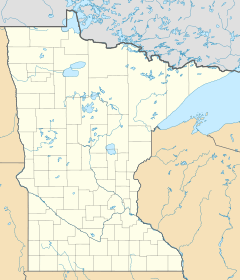Brown's Creek (St. Croix River tributary) facts for kids
Quick facts for kids Brown's Creek |
|
|---|---|
|
Mouth of Brown's Creek
|
|
| Country | United States |
| State | Minnesota |
| Region | Washington County |
| City | Stillwater |
| Physical characteristics | |
| Main source | Withrow, Minnesota 992 ft (302 m) 45°07′08″N 92°53′57″W / 45.11889°N 92.89917°W |
| River mouth | Confluence with the St. Croix River Stillwater, Minnesota 670 ft (200 m) 45°07′08″N 92°53′57″W / 45.11889°N 92.89917°W |
Brown's Creek is a stream in Minnesota, United States. It is about 9.7-mile-long (15.6 km). The creek starts about 5.5 miles northwest of Stillwater. It flows south for half its length, then turns east. Finally, it joins the St. Croix River just north of Stillwater. Brown's Creek is special because it is one of the few creeks in the Twin Cities area that has a healthy population of trout.
Contents
History of Brown's Creek
How Brown's Creek Got Its Name
Brown's Creek is named after Joseph R. Brown. He was the first person to start a settlement in the Stillwater area. In 1840, Brown, a former soldier, set up a small warehouse. This warehouse was at the top of Lake St. Croix. He used it to supply his fur trading business further up the river.
This area, which is now part of northern Stillwater, became the main town for St. Croix County, Wisconsin Territory. Brown started building a courthouse and a jail. He also encouraged people to move to his new village, which he called Dacotah.
The Tamarack House
Several of Brown's family members moved there. This included his half-sister Lydia Ann and her husband, Paul Carli. They lived in a house made of tamarack logs. This house, known as "Mrs. Carli's" or the Tamarack House, became a popular stop. Travelers on the St. Croix River often visited it. However, not many other settlers arrived in Dacotah. More people came to the area when a mill was built to the south, in what became the city of Stillwater.
Where Does Brown's Creek Flow?
The Creek's Path and Water Sources
The area that feeds Brown's Creek is called its watershed. This watershed includes several lakes. These lakes are School Section Lakes, Goggins Lake, Long Lake, and Benz Lake. Water from these lakes flows into Brown's Creek.
The creek flows through a beautiful area called Brown's Creek Park and Nature Preserve. This park is located northwest of Stillwater. After leaving the park, the creek continues to flow east. It then meets the St. Croix River.
Changes to the Creek Over Time
Long ago, Brown’s Creek was rerouted into McKusick Lake. This lake then supplied water to the people living in Stillwater. But by 1955, experts realized that the warm lake water was harming the trout in Brown’s Creek. To help the trout, a wall, called a dike, was built. This dike separated the creek from the lake. It made sure the creek's water flowed directly back into Brown's Creek. This dike is still there today.
In 1999, another big change happened. A section of Brown's Creek was rerouted again. This made the stream much shorter, going from 5,130 feet to 2,000 feet. The goal was to make the water cooler. The old path went through a wetland, which warmed the water. The new path helped the water flow faster and reduced unwanted materials in the stream. This project was done by the city of Stillwater and the Minnesota Department of Natural Resources. They also replanted natural plants along the creek where it crosses the Oak Glen Golf Course.
Life in Brown's Creek
Why is the Creek Important for Fish?
Brown's Creek is home to many fish and tiny water creatures. Since 2002, the Minnesota Pollution Control Agency has listed the creek as "impaired." This means that the numbers of fish and macroinvertebrates (small creatures without backbones) are lower than they should be.
Several things can harm the fish and other creatures. These include too much dirt in the water (total suspended solids), high water temperatures, and not enough oxygen in the water. Also, two harmful substances, copper and nitrate-nitrite (NOx), have been found. High levels of NOx can cause problems for trout. It can lead to a condition called "brown blood disease." It can also make trout grow slower and affect their ability to have babies.
Trout in the Creek
Since 1955, the Minnesota Department of Natural Resources has added non-native Brown trout (Salmo trutta) to the creek. Students from Stillwater have been checking the water quality in Brown's Creek since 1998. This helps them understand how healthy the creek is.
Beavers and Trout: A Natural Debate
Recently, there has been a discussion about beavers (Castor canadensis) in the creek. Some people who support brown trout worry that beaver dams are making the water warmer. They also think the dams stop trout from moving freely.
However, the idea of trapping and killing beavers is debated. Scientific studies have shown that beaver dams can actually help brown trout. For example, studies in the Sierra Nevada mountains and in Sweden found that trout were bigger in beaver ponds. These ponds also provide a safe place for larger trout in small streams, especially during dry periods.
Deep water in beaver ponds also offers a safe place for trout in winter. It protects them from ice in small streams like Brown's Creek. Also, beaver dams can raise the groundwater level. This creates a larger hyporheic zone, which is an area under the stream bed. This zone can be very important for trout when they lay their eggs.


